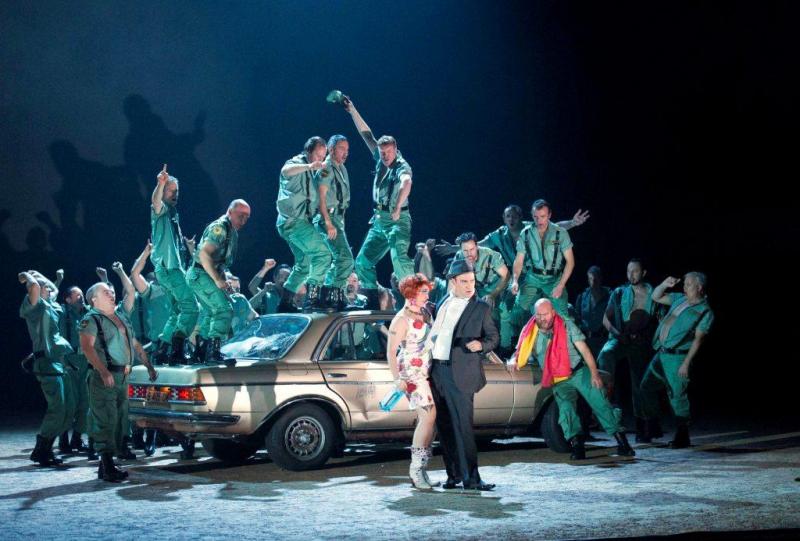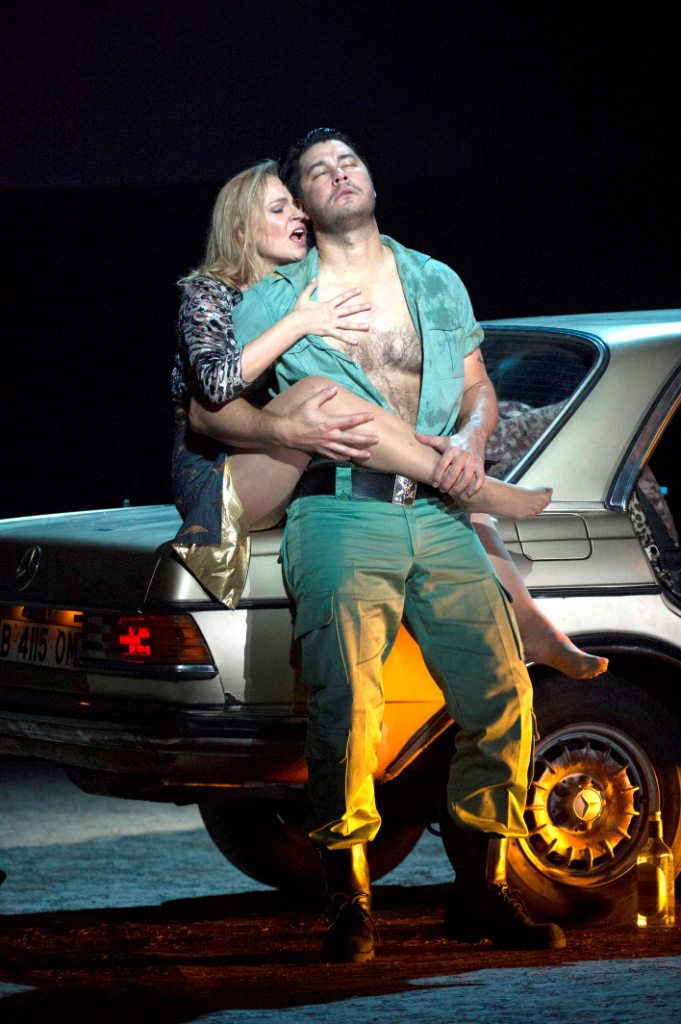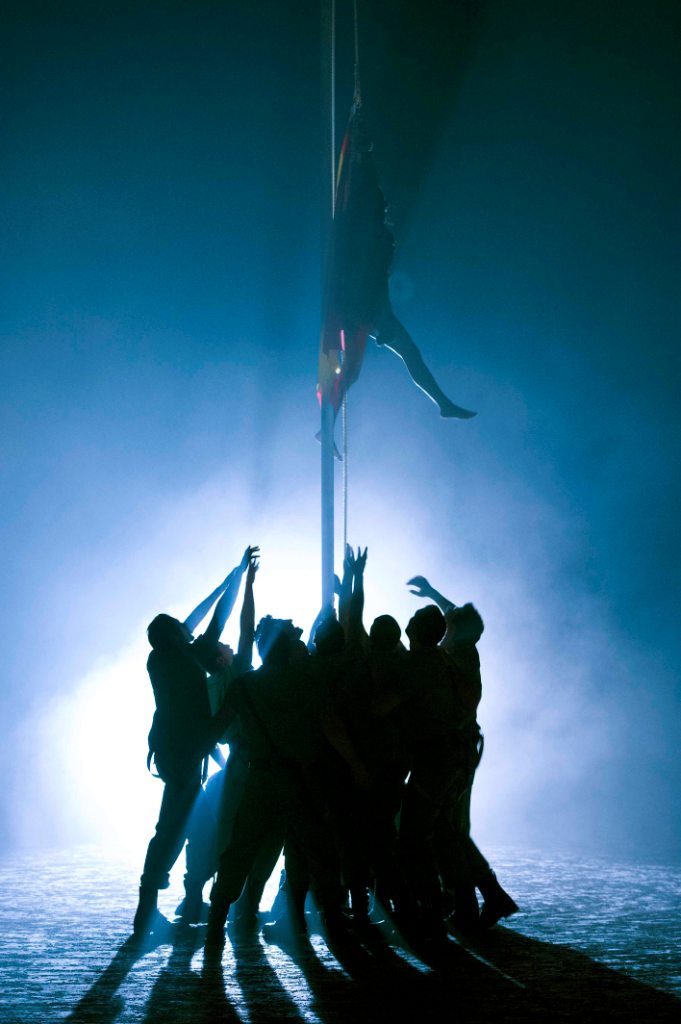Carmen, English National Opera | reviews, news & interviews
Carmen, English National Opera
Carmen, English National Opera
A visually satisfying production ultimately fails to gel on the night

We had already been reassured in interviews that Calixto Bieito’s production of Carmen would not be shocking, although perhaps this was more a warning to those of us hoping that it might be. Bieito’s radical reputation is well earned, although approaching 50 he is by no means an enfant and clearly not so terrible anymore either.
The first scene opens with a soldier wearing nothing but Y-fronts and boots, holding a rifle and running round the stage, presumably as a punishment handed out by Corporal Moralès or Lieutenant Zuniga. In fact, there are bits and bobs of undressing at various stages of the production, though nothing one could call gratuitous – apart from the fully nude male dancer during the Act III prelude, and even he is dimly lit and shrouded in a modesty mist.
 There is a surprise in store, though. The cigarette factory bell rings and the soldiers, with much jostling and thrusting of loins, prepare to ogle the women workers. Out comes Carmen, jet-black hair and a sultry pout; "phwoar" say the soldiers, or words to that effect, as she languidly strolls past them and lights a cigarette downstage. Except, what’s this? Why are they asking where Carmencita is, when she is right there? Turns out that isn’t her after all, it is just an actress apparently cast to look exactly like you’d expect Carmen to look, so that when Ruxanda Donose appears – blonde, distinctly un-Spanish – our expectations are confounded.
There is a surprise in store, though. The cigarette factory bell rings and the soldiers, with much jostling and thrusting of loins, prepare to ogle the women workers. Out comes Carmen, jet-black hair and a sultry pout; "phwoar" say the soldiers, or words to that effect, as she languidly strolls past them and lights a cigarette downstage. Except, what’s this? Why are they asking where Carmencita is, when she is right there? Turns out that isn’t her after all, it is just an actress apparently cast to look exactly like you’d expect Carmen to look, so that when Ruxanda Donose appears – blonde, distinctly un-Spanish – our expectations are confounded.
It must have been intentionally playful, except the result is that Donose (pictured above right with Adam Diegel’s José) is undermined before she even begins the evening’s hard slog of trying to convince the audience that she is the raunchy, animalistic, hedonistic and fickle heroine who would ultimately become the victim of her own irresistible charms. It doesn’t work – she is just too nice, too awkward. Her costume for most of it hampers her efforts further: it must be hard to be wild when you’re wearing high heels and a pencil skirt.
In an opera with, at best, dubious attitudes to women (the clingy, homely Micaela versus the femme fatale Carmen), the failure here is not in trying to avoid the stereotypes, but rather in trying hard to fulfil them and falling short. It does not help that the part seems to sit rather low in Donose’s voice, so she is never the most sparkling, vital thing on stage: if Carmen isn’t that, then what is she? It is important to add that Donose has a beautiful voice, warm and rounded, and well worth checking out. But things did not gel for her last night.
 Adam Diegel’s José also started rather underpowered, his bright, forward tenor feeling a little strangulated, but he loosened up in time to give an admirable account of his big second act aria, and kept it up to the bitter end. It is the bit parts that steal show, though, with Rhian Lois and Madeleine Shaw as Frasquita and Mercédès being particular highlights. They are both natural actors, and raise a fair few laughs along the way. Duncan Rock as Moralès is also impressive, not least thanks to his Action Man physique, while a genuinely intimidating Graeme Danby is the lewd and gruff Zuniga. Elizabeth Llewellyn’s Micaëla, though a dreadful drip of a role, gets probably the warmest applause, and well-deserved too.
Adam Diegel’s José also started rather underpowered, his bright, forward tenor feeling a little strangulated, but he loosened up in time to give an admirable account of his big second act aria, and kept it up to the bitter end. It is the bit parts that steal show, though, with Rhian Lois and Madeleine Shaw as Frasquita and Mercédès being particular highlights. They are both natural actors, and raise a fair few laughs along the way. Duncan Rock as Moralès is also impressive, not least thanks to his Action Man physique, while a genuinely intimidating Graeme Danby is the lewd and gruff Zuniga. Elizabeth Llewellyn’s Micaëla, though a dreadful drip of a role, gets probably the warmest applause, and well-deserved too.
The chorus scenes are a joy, the shabbily gaudy costumes quite appropriately bringing to mind Emir Kusturica films, while presenting the gypsies as economic migrants, or even perhaps illegal immigrants, gives things an interesting spin. And though any admiration for staging restraint, compared to the pointless extravagance of Francesca Zambello’s effort at Covent Garden, is somewhat revised after the appearance of five(!) battered Mercedes for Act III, visually it is a both coherent and satisfying production, and there is no reason that it shouldn’t become a firm part of ENO’s stable for years to come.
A rather peculiar moment deserves mention, though. Merrily dressing up a Bambi-limbed child in pink tights and lipstick and dragging her off to join the women in "distracting the customs officers" is a directorial interpolation as uncomfortable to watch as it is unnecessary to the plot.
Add comment
The future of Arts Journalism
You can stop theartsdesk.com closing!
We urgently need financing to survive. Our fundraising drive has thus far raised £49,000 but we need to reach £100,000 or we will be forced to close. Please contribute here: https://gofund.me/c3f6033d
And if you can forward this information to anyone who might assist, we’d be grateful.

Subscribe to theartsdesk.com
Thank you for continuing to read our work on theartsdesk.com. For unlimited access to every article in its entirety, including our archive of more than 15,000 pieces, we're asking for £5 per month or £40 per year. We feel it's a very good deal, and hope you do too.
To take a subscription now simply click here.
And if you're looking for that extra gift for a friend or family member, why not treat them to a theartsdesk.com gift subscription?
more Opera
 Albert Herring, English National Opera review - a great comedy with depths fully realised
Britten’s delight was never made for the Coliseum, but it works on its first outing there
Albert Herring, English National Opera review - a great comedy with depths fully realised
Britten’s delight was never made for the Coliseum, but it works on its first outing there
 Carmen, English National Opera review - not quite dangerous
Hopes for Niamh O’Sullivan only partly fulfilled, though much good singing throughout
Carmen, English National Opera review - not quite dangerous
Hopes for Niamh O’Sullivan only partly fulfilled, though much good singing throughout
 Giustino, Linbury Theatre review - a stylish account of a slight opera
Gods, mortals and monsters do battle in Handel's charming drama
Giustino, Linbury Theatre review - a stylish account of a slight opera
Gods, mortals and monsters do battle in Handel's charming drama
 Susanna, Opera North review - hybrid staging of a Handel oratorio
Dance and signing complement outstanding singing in a story of virtue rewarded
Susanna, Opera North review - hybrid staging of a Handel oratorio
Dance and signing complement outstanding singing in a story of virtue rewarded
 Ariodante, Opéra Garnier, Paris review - a blast of Baroque beauty
A near-perfect night at the opera
Ariodante, Opéra Garnier, Paris review - a blast of Baroque beauty
A near-perfect night at the opera
 Cinderella/La Cenerentola, English National Opera review - the truth behind the tinsel
Appealing performances cut through hyperactive stagecraft
Cinderella/La Cenerentola, English National Opera review - the truth behind the tinsel
Appealing performances cut through hyperactive stagecraft
 Tosca, Royal Opera review - Ailyn Pérez steps in as the most vivid of divas
Jakub Hrůša’s multicoloured Puccini last night found a soprano to match
Tosca, Royal Opera review - Ailyn Pérez steps in as the most vivid of divas
Jakub Hrůša’s multicoloured Puccini last night found a soprano to match
 Tosca, Welsh National Opera review - a great company reduced to brilliance
The old warhorse made special by the basics
Tosca, Welsh National Opera review - a great company reduced to brilliance
The old warhorse made special by the basics
 BBC Proms: The Marriage of Figaro, Glyndebourne Festival review - merriment and menace
Strong Proms transfer for a robust and affecting show
BBC Proms: The Marriage of Figaro, Glyndebourne Festival review - merriment and menace
Strong Proms transfer for a robust and affecting show
 BBC Proms: Suor Angelica, LSO, Pappano review - earthly passion, heavenly grief
A Sister to remember blesses Puccini's convent tragedy
BBC Proms: Suor Angelica, LSO, Pappano review - earthly passion, heavenly grief
A Sister to remember blesses Puccini's convent tragedy
 Orpheus and Eurydice, Opera Queensland/SCO, Edinburgh International Festival 2025 review - dazzling, but distracting
Eye-popping acrobatics don’t always assist in Gluck’s quest for operatic truth
Orpheus and Eurydice, Opera Queensland/SCO, Edinburgh International Festival 2025 review - dazzling, but distracting
Eye-popping acrobatics don’t always assist in Gluck’s quest for operatic truth
 MARS, Irish National Opera review - silly space oddity with fun stretches
Cast, orchestra and production give Jennifer Walshe’s bold collage their all
MARS, Irish National Opera review - silly space oddity with fun stretches
Cast, orchestra and production give Jennifer Walshe’s bold collage their all

Comments
Hello? Conductor? Can't blame
Mea culpa, I made some notes
I agree about the use of the
Do the "five Mercs" (picture
Five Mercedes plus one
A footnote to report on
A footnote to report on progress since the first night: I went on Tuesday, and was much more captivated by Bieito's production than I'd expected to be. The Third Act, making fabulous use of the five (plus one) Mercs, was much the best I've seen on stage: Card Scene and Micaela's aria absolute highlights. Singers all well co-ordinated with orchestral sweep, though the conductor for this and one other performance was staff man Martin Fitzpatrick. Good to know that ENO now has such a vibrant production to pull in the punters each season.